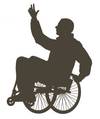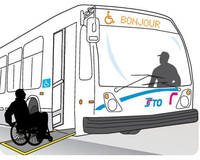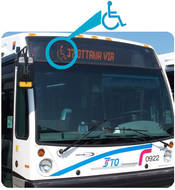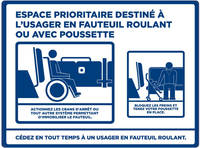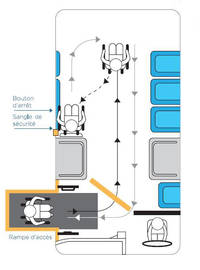Taking the Bus – People in Wheelchairs
People who use wheelchairs have an accessible service on the regular Société de transport de l'Outaouais (STO) system thanks to buses equipped with an access ramp. Before using this service, we recommend that you visit the Accessible Service - People in wheelchairs section of this site to find out more about the nature of the service. You should also make sure that your wheelchair is the compliant size.
The STO intends to offer accessible service to people in wheelchairs throughout the year. However, in the winter, it may happen that service may not be possible at some accessible stops due to the presence of snow or ice.
Here are a few tips and tricks to make travel on the regular system easier in a wheelchair.
Travelling on an accessible bus
1. Plan your trip
See the Accessible Service - People in wheelchair page for more details on the service offered, on how to plan your trip and how to identify an accessible stop and an accessible bus.
2. At the bus stop - Getting on the bus
Clearly signal your intent to get on the bus
Make sure that you are at an accessible stop. Several stops are now equipped with a solar variable message signs. These signs identify the hours of passage of the next trips at this stop, as well as the accessible trips. A push button activates a voice announcement. In addition, all Rapibus stations are accessible.
As the bus approaches, riders who wish to board must clearly signal their intent to the driver. This allows the driver to position the bus properly to deploy the access ramp on the sidewalk.
Safe deployment of the access ramp
To allow the bus driver to deploy the ramp safely, it is important to stay about 2 metres away from the front door. Wait until the ramp is fully extended before using it.
Getting on the bus
Once the other riders have boarded and the access ramp has been deployed on the sidewalk, riders in wheelchairs can get on the bus.
For safety reasons, the bus driver must always stay at the wheel of the vehicle.
Riders must be able to get on the bus and position themselves properly completely unassisted, with or without an attendant.
To become familiar with the use of the access ramp, it is suggested that riders be accompanied on their first trip.
A few tips to follow:
- Make sure that you get on and drop-off at an accessible stop;
- Make sure that the bus shows the accessibility symbol (wheelchair symbol on the bus display);
- Make sure you are attached in your wheelchair before getting on the access ramp;
- Make sure the wheelchair's anti-tip system is engaged;
- Sit properly on the chair and ensure that you counterbalance your weight. The ramp can reach an angle of 10 degrees to the sidewalk.
3. The trip
Priority space on the bus
On regular buses, one space is available to accommodate a rider in a wheelchair. Articulated buses and bus models 2021 and up have two available spaces. This space is easy to find.
Use of this space is shared with riders travelling with a stroller. However, riders in wheelchairs are given priority for this space.
If the priority space is already occupied by someone in a wheelchair
You can travel on this bus if you can:
- Board the bus without assistance using the access ramp;
- Fold your wheelchair and sit on a seat without assistance;
- Stow your wheelchair so it does not obstruct traffic;
- Keep your wheelchair under full control at all times;
- Get off the bus without assistance.
OR
You can board the next wheelchair accessible bus.
Drivers have been instructed to stop at the bus stop, to inform you that all the spaces are occupied and to contact the STO to ensure that space is available on the next trip. If not, in certain cases, an alternative solution could be considered.
If the priority space is already occupied by someone with a stroller
The rider with the stroller must give the spot to the rider in the wheelchair as indicated by the sticker in the vehicle.
If the bus is full
If the bus is full and passengers are standing, you can board the next wheelchair accessible bus.
Drivers have been instructed to stop at the bus stop, to inform you that all the spaces are occupied and to contact the STO to ensure that space is available on the next trip. If not, in certain cases, an alternative solution could be considered.
Positioning in the priority space
Riders must:
- Sit with their back to the entrance of the bus, facing the back of the vehicle;
- Position the back of the wheelchair against the padded cushion;
- Set the brakes or any other system to immobilize the wheelchair.
Safety instructions :
- Attach their wheelchair using the safety strap;
- Hold the handrail on their left;
- Position the front wheel so that it is straight for better stability (three-wheeled scooter).
4. Getting off the bus
It is important to let the bus driver know well in advance that you want to get off the bus by using the blue stop button located on your left. This allows the driver to position the vehicle properly to make it easier for everyone to get off the bus.
The bus driver will let the other riders off first before deploying the access ramp.
For your safety, please be sure to wait until the bus comes to a full stop before detaching your wheelchair and moving towards the front door.
Travelling on a bus without an access ramp
Do you use a wheelchair and would like to take a route that does not offer buses with access ramps and accessible bus stops? You can still do it if you can:
- Board the bus without assistance;
- Fold your wheelchair and sit on a seat without assistance;
- Stow your wheelchair properly by yourself so it does not obstruct traffic;
- Keep your wheelchair under full control at all times;
- Get off the bus without assistance.
Here is the procedure to follow:
- As the bus approaches, get out of your wheelchair and fold it so you don't delay the trip when the bus arrives.
- When the bus is approaching, wave your hand to tell the driver that you intend to board the bus.
- Once the bus has stopped, board the bus carrying your wheelchair with you.
- By yourself, find an empty seat.
- Take care to stow your wheelchair so it does not obstruct traffic.
- When getting off the bus, follow the same procedure.
Note that you cannot board a bus without an access ramp if you are using a scooter or any other motorized device.
Other useful information
For more details about our Accessible Service and amenities:
- Accessible Service - People in wheelchairs
- Taking the Bus - People with Reduced Mobility
- Accessible Service – People with Reduced Mobility
- People with Visual Impairments
- Courtesy Seats
- Attendant Privileges Card for Visual Impairment
- Courtesy Privilege Card for People with Reduced Mobility
- Paratransit service


